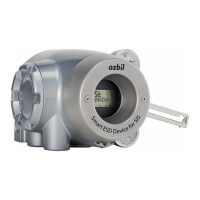2-18
2-3-5 Cables
1) Selection and conditions of cables
The criteria for selection and the conditions of cables for wiring are described below.
• We recommend using 600-V plastic insulated sheath electric wire CVV (JIS C 3401 by
Japanese Industrial Standards) for control with a conductive cross-section of 1.25 mm
2
or a stranded cable with equivalent or higher performance.
• When routing cable in a place subject to electromagnetic noise, use shielded wire
CVVS (JCS 4258 by the Japanese Electric Wire & Cable Makers’ Association) and
metal conduits.
• Select a sheath material that withstands the cable installation environment (including
the ambient temperature, corrosive gas, and corrosive liquid).
• Use cable with an outside diameter of 7 to 12 mm. When using a pressure-resistant
packing cable adapter, be sure to use packing appropriate for the outside diameter of
the cable.
• A crimping terminal with insulated sleeve (for M4 screw) is recommended for terminals.
• The maximum permissible cable length is 1500 m.
2) Cable installation
Comply with the following when installing cables between this device and the actuator.
• Avoid installing cables near devices that generate noise such as large capacity
transformers, motors, or driving power sources.
• Do not install cables in the same tray or duct with other driving power cables.
• We recommend the use of electrical metal conduits and ducts to prevent water and
mechanical damage to electrical lines. Also, always use water-tight glands at conduit
connection ports.
• Use electrical metal conduits and ducts for locations exposed to electromagnetic noise.
• When using shielded cable, the cable must be connected to a single point ground on
the DCS side.
Handling Precautions:
ModelAVP701/702areintendedforuseinindustriallocationsdefinedinCE
markingdirective(EN61326-1).

